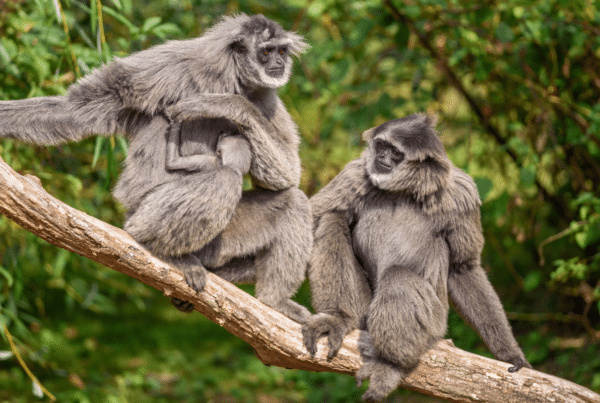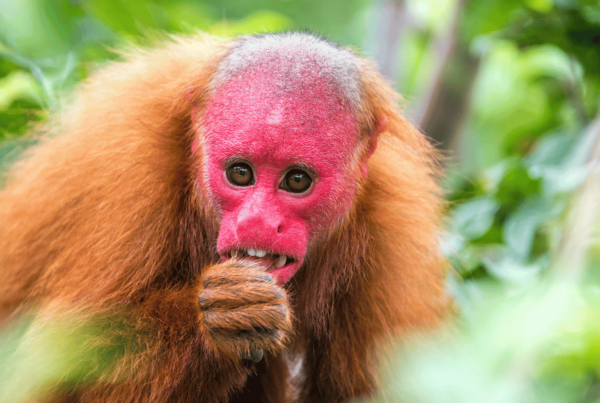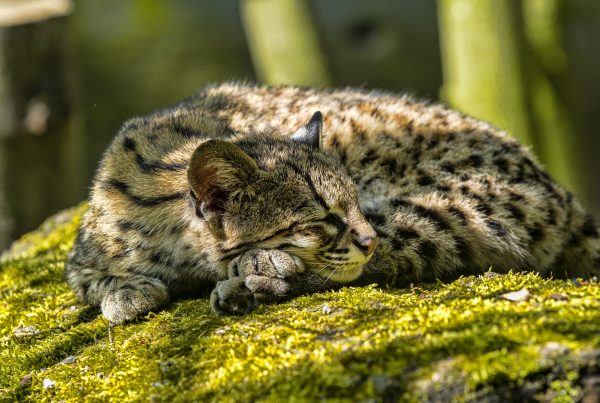Get ready to swing into the wild world of orangutans. From their enormous arm spans to their close bonds with their mothers, there is much to learn about these fascinating primates. Keep reading to uncover ten interesting facts about orangutans and get to know more about the innovative conservation efforts at Stand For Trees, where we are working to preserve the orangutan population and their habitat for future generations.
The Top 10 Orangutan Facts You Need to Know
1) The name orangutan means “forest person.”
Deep in the heart of the tropical rainforests of Borneo and Sumatra live the majestic creature known as the orangutan. These shaggy red apes are unlike any other animal in the forest, as they are largest mammals living high up in the rainforest canopy. Local communities gave them a name that reflects their unique adaptations to life in the forest. The word “orangutan” is derived from the Malay and Indonesian words “orang,” meaning “person,” and “hutan,” meaning “forest.” Together, these words literally translate to “forest person.”[1]
2) Orangutans reign supreme as the largest primates living in trees.
Orangutans are truly remarkable creatures, not only for their physical characteristics but also for their unique way of life. These impressive beasts are known to be the biggest mammals that reside in trees. Life in the lush tropical rainforests is just their cup of tea, spending a whopping 90% of their day among the branches.[2] Hunting for food, building cozy nests, and catching some z’s, all while surrounded by the great outdoors. And let’s not forget, they’ve got their leaf umbrellas at the ready to shield them from any rain showers. This dependence on trees for survival highlights the importance of preserving their habitats and protecting these majestic creatures.
3) An orangutan’s arms are longer than its legs.
When it comes to orangutans, it’s all about the arms. These primates are known for their impressive arm span, with males stretching their arms to a whopping seven feet![3] That’s longer than their standing height of five feet. It’s like they’re constantly reaching for the stars… Or maybe just the next branch. And let’s not forget that their arm strength is impressive too; they use it for swinging from tree to tree, supporting their body weight. Orangutans are the ultimate athletes.
4) The bond between an orangutan mother and her young is unparalleled.
Orangutan mothers are true nurturers, known for their strong maternal instincts and close bonds with their young. They carry their offspring for over two years of their lives and are often seen grooming and playfully interacting with them. But beyond the cute and cuddly moments, these interactions are essential for the survival and development of young orangutans; mothers teach their young how to find food, build a nest, navigate the forest canopy, and socialize.
In fact, orangutans have one of the most prolonged infant dependency periods among primates, with infants remaining dependent on their mothers for up to eight years. Even after the offspring become independent, they will often return to their mother for support and protection throughout their lives.[4]
5) The secret to a long life? Ask an orangutan! They can live up to 60 years.
Orangutans are in it for the long haul. These majestic creatures can live up to nearly fifty years or more in the wild, making them some of the longest-lived primates on the planet.[5]That’s like living long enough to see the internet go from dial-up to 5G! But these long lifespans aren’t just impressive; they’re also crucial for the survival of the orangutan species. With a slow reproductive rate, it’s crucial for orangutans to have a long lifespan to ensure the continuation of the population.
6) Orangutans are incredibly smart.
When it comes to brainpower, orangutans are not monkey-ing around. These creatures are brilliant and possess a level of intelligence that is on par with chimpanzees and gorillas. In fact, they have been observed using tools in the wild! They use sticks to probe for insects and extract seeds from fruit as well as leaves as cups to drink water.[6] But it’s not just their impressive tool-using skills; their cognitive abilities are also quite remarkable. They have been known to solve complex problems and possess a level of self-awareness that is often considered a marker of advanced intelligence.[7]
7) Orangutans and humans are separated at birth, with only 3% DNA difference.
Did you know that orangutans and humans have more in common than opposable thumbs? These apes share an astounding 97 percent of their DNA with us.[8] That’s like having a cousin almost identical to you, with more hair and better balance. But the similarities don’t stop there; orangutans and humans also share many similar traits and behaviors, such as the ability to make and use tools, and the capacity for complex problem-solving. This genetic similarity is a powerful reminder of our connection to the natural world and the importance of preserving the orangutan population.
8) Orangutans mainly eat fruit.
Orangutans are culinary connoisseurs when it comes to fruit selection. Why? Because they are frugivorous, meaning they eat fruit primarily.[9] They have been observed using tools to access hard-to-reach fruits and even have a preference for different types of fruits depending on the season. They have a taste for over 400 different kinds of fruits, including durians, figs, and lychees. But their diet isn’t just a tasty treat; it plays a vital role in seed dispersal and maintaining the biodiversity of the rainforest.
9) Find the king of the trees in the habitats of Sumatra and Borneo.
Orangutans are truly one of a kind, as they are the only great ape species found outside of Africa, inhabiting the Southeast Asian vibrant forests of Sumatra and Borneo.[10] From the towering dipterocarp trees that form the canopy to the sparkling rivers that wind their way through the forest floor, every inch of these rainforests teems with lush life. Borneo and Sumatra also play a critical role in the global climate, acting as carbon sinks and helping regulate weather patterns. Orangutans are symbols of the rainforests’ beauty and a reminder of the critical importance of protecting these ecosystems for future generations.
10) With the three orangutan species being critically endangered, conservation efforts are more important then ever.
The three different types of orangutan, Bornean, Sumatran, and Tapanuli, are currently classified as critically endangered due to the devestating effects of habitat loss, poaching and the illegal pet trade. The destruction of their rainforest habitats for palm oil, paper, and wood products, as well as illegal logging, mining, and land conversion for agriculture, has led to the loss of over 80% of their natural habitat. This has fragmented their populations, making it harder for them to find food and mates, and increasing the risk of extinction. Only 104,700 Bornean orangutans are left in the wild compared to 230,000 a decade ago. That’s about a 55% decrease in population in just ten years![11]
However, there is hope for these incredible animals. Organizations like Stand For Trees are working to protect orangutans and their habitats through conservation projects such as the Rimba Raya Orangutan Reserve project. This project aims to protect and restore over 47,000 hectares of rainforest in Borneo, providing a safe haven for orangutans and other endangered species. It also manages the ex-captive orangutan population, providing daily feedings and medical services. By supporting this project, you can help ensure a future where orangutans can continue to swing through the lush rainforests.
We hope you enjoyed learning these ten facts about our orangutan cousins. They’re depending on you, so take action now.
Join us and save wildlife now.
[1] https://www.britannica.com/animal/orangutan
[2] https://www.worldatlas.com/articles/where-do-orangutans-live
[3] https://www.livescience.com/55088-orangutans
[4] https://orangutan.org/orangutan-facts/orangutan-behavior
[5] https://www.nationalgeographic.com/animals/mammals/facts/orangutans
[6] https://www.nature.com/articles/d41586-022-00872-3
[7] https://www.sciencedirect.com/science/article/abs/pii/S0047248481800164
[8] https://www.nih.gov/news-events/nih-research-matters/orangutan-genome-sequenced
[9] https://www.orangutanrepublik.org/learn/orangutan-specifics/diet/
[10] https://www.discoverwildlife.com/animal-facts/mammals/facts-about-orangutans/
[11] https://www.iucnredlist.org/search?query=orangutan&searchType=species









